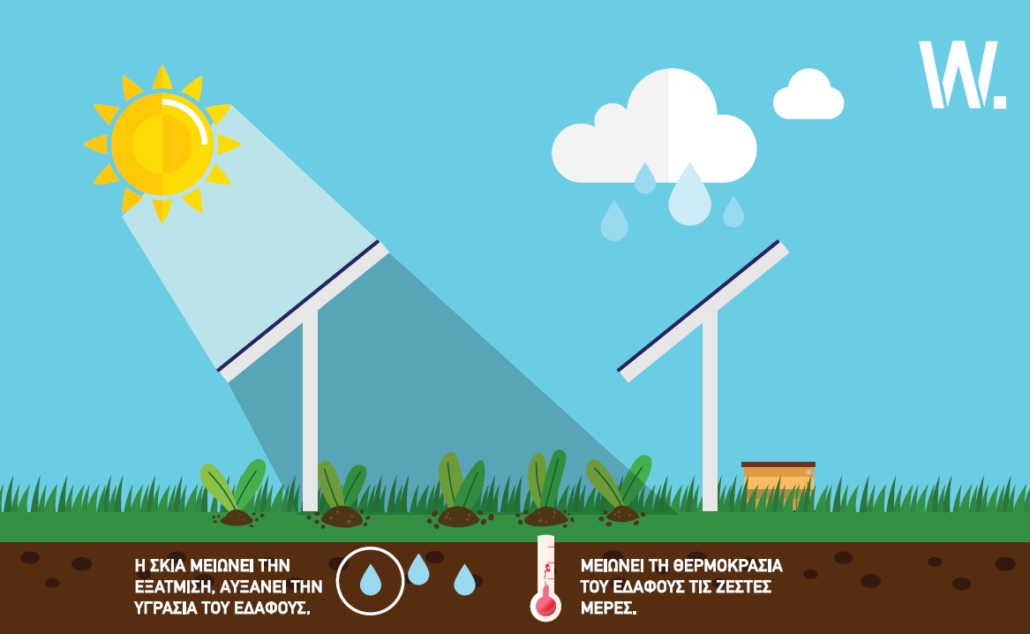Written by Aggeliki Marinou, environmental engineer at Wattcrop.
Water scarcity is a pressing global challenge affecting agriculture, energy production and the environment. In recent years, the concept of agrovoltaics has emerged as a promising solution to sustainably address both water and energy needs. Agro-photovoltaics, involve the integration of solar panels with agricultural activities on the same land. By combining agricultural activities and solar energy production, agro-voltaic systems bring many benefits as farmers can optimize land use, conserve water and promote a more resilient and efficient agricultural system. In this article, we explore the various ways in which agro-photovoltaics can save water and contribute to a more sustainable future.
Efficient Water Management
One of the primary benefits of agrivoltaics is the ability to implement efficient water management practices. Drip irrigation systems, for instance, deliver water directly to plant roots, reducing evaporation and water wastage. Farmers can also use soil moisture sensors to monitor the water content in the soil, allowing them to water crops only when needed. These measures not only conserve water but also promote healthier crop growth and increased yields.
Rainwater Harvesting
 Agrivoltaic systems can be designed to incorporate rainwater harvesting techniques. Solar panels can collect rainwater, which is then stored and used for irrigation during dry periods. By harnessing nature’s gift, farmers can reduce their reliance on traditional freshwater sources, mitigating the impact of water scarcity on agricultural production.
Agrivoltaic systems can be designed to incorporate rainwater harvesting techniques. Solar panels can collect rainwater, which is then stored and used for irrigation during dry periods. By harnessing nature’s gift, farmers can reduce their reliance on traditional freshwater sources, mitigating the impact of water scarcity on agricultural production.
Choosing Water-Efficient Crops
Selecting the right crops is essential for water conservation in agrivoltaics. Opt for drought-resistant or native plants that are well-adapted to the local climate. These crops require less water for growth, making them ideal choices for regions facing water scarcity challenges.
Mulching for Water Retention
Applying organic mulch around the base of crops helps retain soil moisture by reducing evaporation. Mulching also suppresses weed growth, which can compete with crops for water resources. With reduced water loss from the soil, farmers can maintain optimal moisture levels for crop growth while minimizing water usage.
Windbreaks for Water Conservation
Planting windbreaks or hedges around agrivoltaic systems can have significant water-saving benefits. Windbreaks reduce wind evaporation from the soil surface, preserving water and protecting crops from wind damage. Moreover, windbreaks create a microclimate that can further improve water use efficiency for neighboring crops.
Companion Planting Techniques
Companion planting is a practice where certain crops are planted together to create symbiotic relationships. Some companion plants can aid in water conservation by providing shade,
reducing evaporation, and improving soil moisture retention. Integrating these plant combinations into the agrivoltaic system can optimize water usage and promote a healthier ecosystem.
Smart Irrigation Solutions
Modern technology can enhance water-saving efforts in agrivoltaics. Smart irrigation controllers take into account weather forecasts, soil moisture levels, and crop water requirements to optimize watering schedules. This data-driven approach ensures that crops receive the precise amount of water they need, minimizing wastage and conserving water resources.
Sustainable Solar Panel Design
Efficient solar panel design is crucial for agrivoltaics. Panels should be mounted with adequate spacing and orientation to ensure that crops receive sufficient sunlight for growth. This design prevents excessive shading and maintains the productivity of the agricultural land, which can be compromised if crops are deprived of essential sunlight.
Agrivoltaics presents a promising pathway towards water-saving agriculture and sustainable energy production. By integrating solar panels and agricultural activities, farmers can optimize land use, conserve water, and bolster the resilience of their farming systems. Implementing efficient water management practices, utilizing rainwater harvesting, selecting water-efficient crops, and embracing modern technologies can all contribute to a more sustainable future for agriculture. As we confront the challenges of water scarcity and climate change, agrivoltaics stands as a beacon of hope, demonstrating how innovation and collaboration can pave the way towards a greener and more prosperous world.
Find more insightful articles by the Wattcrop team!
View our guide about agrivoltaics!


